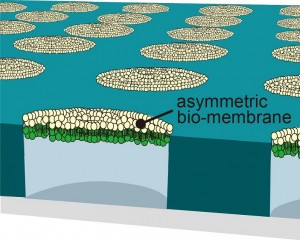Novel high-throughput micro-device to form asymmetric bio-membranes Toward medical and pharmacological applications

The research group of Dr. Rikiya Watanabe and Prof. Hiroyuki Noji at the University of Tokyo Graduate School of Engineering have developed a novel micro-device in which more than 10,000 artificial lipid bilayers (artificial bio-membranes having the same structure as biological membranes but comprised of artificial lipids) with an asymmetric lipid composition are integrated.
The lipid composition is different between the inner and outer layers (“leaflets”) of the asymmetric bio-membrane, and this asymmetry is constantly maintained by membrane-embedded enzymes. Various physiologic functions such as signal transmission and apoptosis (programmed cell death) are regulated by the lipid compositional asymmetry, and therefore, a highly sensitive method for measuring disruption of lipid asymmetry had long been sought for.
Although liposomes have been widely used to measure lipid asymmetry disruption, it is technically challenging to control the lipid compositional asymmetry in a highly reproducible manner, and moreover, to detect the lipid asymmetry disruption with high sensitivity due to incompatibility with the indicator of lipid asymmetry.
To address the issue, the research group succeeded in creating asymmetric lipid bilayers in a high throughput manner, and developed a novel micro-device in which more than 10,000 artificial lipid bilayers with an asymmetric lipid composition are integrated. By using this micro-device, the group for the first time succeeded in carrying out a highly sensitive and long-time analysis of lipid asymmetry disruption at the single bio-membrane level.
It is highly expected that the developed technologies pave the way for novel medical and pharmacological applications, e.g. understanding diseases such as Alzheimer’s and cancer that are related to membrane asymmetry and drug screening platforms targeting the enzymes which maintain asymmetric lipid distribution.
Paper
Rikiya Watanabe, Naoki Soga, Tomoko Yamanaka, & Hiroyuki Noji,
“High-throughput formation of lipid bilayer membrane arrays with an asymmetric lipid composition”,
Scientific Reports 4, Article number:7076, Online Edition: 2014/11/17, doi: 10.1038/srep07076.
Article link (Publication, UTokyo Repository)
Links
Graduate School of Engineering
Department of Applied Chemistry, Graduate School of Engineering
Noji Laboratory, Department of Applied Chemistry, Graduate School of Engineering (Japanese)








